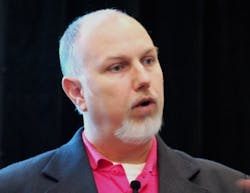Check out ControlGlobal.com on Google+ and Keith Larson's Google+ profile.
Few would argue that we live in an era of incredible change and uncertainty—and that the velocity of change seems to increase every day. But technology, while it continues to advance at a breakneck speed, is not a main contributor to uncertainty about the future. "Forecasting technology is the easy part," argues Tom Koulopoulos, "It's human behavior that we can't predict."Koulopoulos, author and founder of the Delphi Group, presented his views on the future of innovation at this week's gathering of users of Invensys Operations Management's Wonderware and Avantis software products in Anaheim, Calif.
To deal with uncertainty, people create patterns based on the past to deal with the future, and in the end we're often "held hostage by our data," Koulopoulos said. We may like to think of ourselves as innovative, but we create patterns based on past data to deal with uncertainty, to put new developments into a familiar box. "No matter who we are, the lens through which we see the world gets cloudy."
"No matter who we are, the lens through which we see the world gets cloudy." Tom Koulopoulos on the human tendency to resist behavioral change.
Innovation, he further argued, relies not on technology but on our ability to forge connections that can break us out of the boxes we're in—people with other people, people with machines and, increasingly, machines with other machines. Machines, he noted, are particularly good at identifying new patterns that people miss. Indeed, today's business analytics, which for the most part rely on observations of past behavior, will soon be replaced by forward-looking analytical tools that can identify patterns in data not yet acted upon.Koulopoulos referenced early market predictions for the cell phone that predicted worldwide saturation at 100 million units. Instead, we're now at 5 billion and counting. Many of these connections, he noted, are not among people but among machines. The number of these machine-to-machine connections is growing most quickly, and will reach 100 billion by 2020—a number that coincidentally enough equals the number of neurons in the human brain. "There's a radical shift in how we behave being captured by these devices," Koulopoulos said. "We are building a new form of intelligence that resides in machines. Consider a system that innovates itself. We'll create value beyond anything that we can imagine."
A more immediate discussion of the primacy of data and growing importance of machine-to-machine connectivity came from Buck Woody, senior technology specialist for Microsoft. In his discussion, "Virtualization as a Step to the Cloud," Woody first dismissed "the cloud" as marketing fluff: "Think of it as distributed computing. All it means is doing some or all of your computing somewhere else."
Like taking a taxi, renting a car, or buying one, distributed computing services such as Microsoft's Azure platform allow users the option to purchase infrastructure as a service (IaaS), platform as a service (PaaS) or software as a service (SaaS) depending on specific needs and requirements. A growing number of Invensys Operations Management clients, for example, are using cloud-based services for a range of reporting and data analysis tasks as well as virtualization technology to reduce project implementation costs and ongoing system maintenance.
"The best way to a good idea is to have lots of ideas," Woody concluded, paraphrasing Linus Pauling. Whether virtualization, cloud or distributed computing," it's not a panacea, just a set of options."









